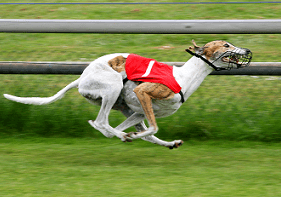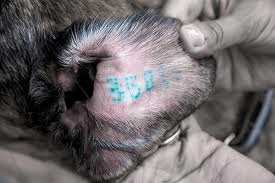Greyhound racing as we know it today developed out of traditional hare coursing and dates back to the early 1900’s when dogs first began racing the oval tracks. The industry is worth big bucks – billions, in fact. Spectators gather, place their bets, and share in the anticipation of race night just as horse enthusiasts revel in the Grand National. 'Going to the dogs' might be a popular pastime for some, but can we really class it a ‘sport’ when thousands of greyhounds are raced to death every year?
Knowing little about it myself, I thought it best to steer clear of total judgement and present only the 'facts' on modern-day racing. There will always be those that stand by the claim 'greyhounds love to run' and say that banning the sport will bring an end to the greyhound breed, create hundreds of job losses and drive the industry underground.
Agreed, there might be some truth in this, but when it comes to the longevity of the breed, greyhounds have always enjoyed a modest following and will continue to have appeal outside of racing - as domestic pets and companion animals. Greyhounds have existed since the time of the ancient Egyptians and haven't always been exploited for their natural speed. Thus, why should an end to the sport necessarily mean an end to the breed?
 In an ideal world, greyhound racing would be driven by a dog's love of running, not by profit. Greyhounds would be well trained and treated off-track, appropriately kennelled and transported, shown love, affection and the everyday comforts all dogs need to thrive, fed a healthy diet free from steroids and other harmful, performance-enhancing drugs, and provided for accordingly once their racing days have ended.
In an ideal world, greyhound racing would be driven by a dog's love of running, not by profit. Greyhounds would be well trained and treated off-track, appropriately kennelled and transported, shown love, affection and the everyday comforts all dogs need to thrive, fed a healthy diet free from steroids and other harmful, performance-enhancing drugs, and provided for accordingly once their racing days have ended.
For a lucky handful of greyhounds, this is their reality. However, far too few dogs experience appropriate care during and after their racing careers. Allegedly, many are brutally punished if they lose a race or under-perform, are hauled into cramped kennels and transportation crates for many hours a day, and are even forced to race with an existing injury or arthritis (10% of greyhounds begin a race with an affliction). In fact, many do not even make it onto the racetrack, either because they are deemed too weak or too slow, and are violently culled by their breeders. This is believed to be the fate for some 12,000 greyhound pups born every year.
Broken bones, dislocation, muscle rupture, heart attacks and related injuries come with the territory of racing. Because the dogs run in such close proximity to one another, at such speeds, injuries like these are unsurprising. At Manchester's Belle Vue track in May 2002, two dogs were killed when they fell and broke their necks. In the very same year, a dog named Santa Power broke its leg and was later destroyed, and another, Football Focus, died of heat exhaustion following a race.
If a dog is particularly successful on the racetrack (and, therefore, valuable to its owner), an existing injury might be treated in order for the dog to recoup and make a hasty return to the fast lane. Sometimes the dog will continue being raced on the injury until it inevitably drops. If the dog is injured beyond the point of recovery, it is usually killed outright. Greyhound Rescue Wales states that the favourite methods for killing an injured or failing dog "include battering to death, poisoning, drowning, shooting, or simply being left to starve to death in a locked shed." There have also been reported cases of dogs being injected with brake fluid or baking soda, causing them to die a slow, painful death.
Unfortunately, race fixing is also commonplace in the industry and it is not unheard of for favourite runners to be doped with cocaine to make them lose. Allegedly, hundreds of greyhounds are also shipped abroad every year, to countries such as Spain where they are 'retired.' The fate of these dogs once they reach their destination is no secret; greyhounds are often kept in appalling conditions and are routinely hanged when they are no longer useful.
 Some 10-12,000 greyhounds are retired from racing every year because of minor injury, old age (3 years +) or under-performance. Sadly, the fate of these dogs is uncertain and it is feared that most end up being killed or badly neglected by their owners. Many simply disappear off the map once their racing days are numbered, with no indication as to where they have gone. Despite their long life expectancies of 12-15 years, racing greyhounds are usually retired between 2-5 years old when they are deemed 'too slow,' meaning most are still only youngsters when they are destroyed.
Some 10-12,000 greyhounds are retired from racing every year because of minor injury, old age (3 years +) or under-performance. Sadly, the fate of these dogs is uncertain and it is feared that most end up being killed or badly neglected by their owners. Many simply disappear off the map once their racing days are numbered, with no indication as to where they have gone. Despite their long life expectancies of 12-15 years, racing greyhounds are usually retired between 2-5 years old when they are deemed 'too slow,' meaning most are still only youngsters when they are destroyed.
Thankfully, due to widespread interest in adopting retired greyhounds, many find themselves in forever homes once their racing careers have ended. However, due to the enormous number of greyhounds being retired annually, finding a home for each and every one of them is impossible. Also, due to the many misconceptions surrounding having greyhounds as pets i.e. their high exercise needs, hyperactivity and incompatibility with children, some people are reluctant to adopt them.
Thousands of dogs of many different breeds wind up in shelters every year and, unfortunately, greyhounds are not everyone's first choice. For this reason, hundreds of ex-racing greyhounds are disposed of once their purpose has been served, whether humanely or otherwise. More disturbingly, many greyhounds have their ears cut off before being abandoned or killed, in order to remove the identification number that traces the dog back to its owner.
 In 2007, a 57 year old man named David Smith was arrested after 10,000 slaughtered greyhounds were found on his property. In what was described as a 'killing field,' Smith had buried retired but otherwise healthy dogs after shooting them with a bolt gun. The unsuspecting dogs were taken into a shed, shot in the head, and dragged into a pre-dug ditch for £20 a time.
In 2007, a 57 year old man named David Smith was arrested after 10,000 slaughtered greyhounds were found on his property. In what was described as a 'killing field,' Smith had buried retired but otherwise healthy dogs after shooting them with a bolt gun. The unsuspecting dogs were taken into a shed, shot in the head, and dragged into a pre-dug ditch for £20 a time.
Smith admitted that, while his activities were unprofitable, they had got a little 'out of control' in the 18 months prior to his arrest. He also claimed that the dogs were only killed because they were unsuitable for re-homing, either because they were too aggressive or too badly injured. While Smith was prosecuted for owning a landfill site without a permit, his actions were not considered inhumane and his owning a bolt gun was perfectly legal.
Although there will always be exceptions, it is evident that the greyhound racing industry has a lot to answer to. However you look at it, the statistics for over-breeding, race injuries and selective culling do not read well. For the fortunate few that end up being re-homed and shown nurturing relationships, their story has a happy ending. However, for the rest that find themselves raced into the ground, only to be killed before their 5th birthday because they are no longer profitable, their story couldn't be more tragic.
Over the past 65 years, the number of race stadiums in England has decreased from around 80 to 25, indicating the sport might actually be on its way out. While the fear of breed decline will always be there, hopefully the enduring popularity of the greyhound will win through and people will continue to have them as pets, even after the sport of racing has ended. If you have any thoughts on this discussion, please share them with us! Likewise, we would love to hear your adoption stories, so please comment below :)
Feel free to contact me directly with any further questions and/or suggestions for future blog posts: [email protected].
Written by: Hannah








